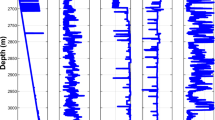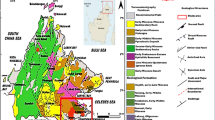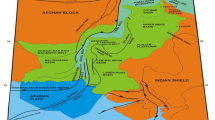Abstract
A robust methodology to determine geological facies in oil and gas fields is the integration of seismic attributes and well data to estimate flow zone indicator (FZI). Recently, the application of fuzzy and Neuro-Fuzzy approach regarding this purpose has enjoyed an increasing attention. The current study was carried out in the Surmeh (Arab) formation at Persian Gulf basin, Southern Iran. A Nero-fuzzy system was applied to estimate FZI cube from seismic attributes. To do so, core data and seismic data from four wells were imported to ANFIS system. Subsequently, the outcomes were compared with those of probabilistic neural network (PNN). Finally, a fuzzy C-Means clustering (FCM) technique was applied to characterize different hydraulic flow units (HFUs). The results of this study demonstrate that adaptive neuro-fuzzy inference systems (ANFIS) turn out to be successful in modeling FZI from seismic attributes and well data for a faraway well location. Moreover, the results achieved suggest that using the FCM technique is an efficient methodology to determine different HFUs from FZI cube.









Similar content being viewed by others
References
Amaefule JO, Altunbay M, Tiab D, Kersey G (1993) Enhanced reservoir description: using core and log data to identify hydraulic (flow) units and predict permeability in uncored intervals/wells. SPE Paper 26436:1–16
Aristimun OJ, Aldana M (2006) Fuzzy logic prediction of petrophysical parameters (porosity and velocity) at La Faja del Orinoco, Venezuela, European Geoscience Union, Geophysical Research Abstracts 8:25–38
Balch RS, Stubbs BS, Weiss WW (1999) Using artificial intelligence to correlate multiple seismic attributes to reservoir properties. Proc Soc Pet Eng Ann Tech Conf Houston, TX, USA 15(1):553–566
Bear J (1972) Dynamics of fluids in porous media. Elsevier, New York
Bezdec JC (1981) Pattern recognition with fuzzy objective function algorithms. Plenum Press, New York, p 256
Chopra S, Pruden D, Alexeev V (2004) Multiattribute seismic analysis-tackling non-linearity. First Break 22:43–47
Dezfoolian MA, Riahi M Ali, Kadkhodaie-Ilkhchi A (2013) Conversion of 3D seismic attributes to reservoir hydraulic flow units using a neural network approach: an example from the Kangan and Dalan carbonate reservoirs, the world’s largest non-associated gas reservoirs, near the Persian Gulf. Earth Sci Res J 17(2):75–85
Ebanks WJ (1987) (Flow unit concept-integrated approach to reservoir description for engineering projects. AAPG, Meet Abstr 1(5):521–522
Ghiasi-Freez J, Kadkhodaie-Ilkhchi A, Ziaii M (2012) Improving the accuracy of flow units prediction through two committee machine models: an example from the South Pars Gas Field, Persian Gulf Basin, Iran. Comput Geosci 46:10–23
Hathaway R, Bezdek J (1988) Recent convergence results for the fuzzy c-means clustering algorithms. J Classif 5(2):237–247
Iravani M, Rastegarnia M, Javani D, Sanati A, Hajiabadi SH (2017) Application of seismic attribute technique to estimate the 3D model of hydraulic flow units: a case study of a gas field in Iran, Egypt. J Petrol. doi:10.1016/j.ejpe.2017.02.003
Kadkhodaie-Ilkhchi A, Rezaee MR, Moallemi SA (2006) A fuzzy logic approach for the estimation of permeability and rock types from conventional well log data: an example from the Kangan reservoir in Iran Offshore Gas Field, Iran. J Geophys Eng 3:356–369
Kamali MR, Mirshady AA (2004) Total organic carbon content determined from well logs using ΔlogR and neuro fuzzy techniques. J Petrol Sci Eng 45:141–148
Kiaei H, Sharghi Y, Kadkhodaie-Ilkhchi A, Naderi M (2015) 3D modeling of reservoir electrofacies using integration clustering and geostatistic method in centralfield of Persian Gulf. J Pet Sci Eng 135:152–160
Matlab user’s guide (2007) Matlab CD-room. Math works, USA
Meldahl P, Heggland R, Bril B, de Groot P (2001) Identifying faults and gas chimneys using multiattributes and neural networks. Lead Edge 20:474–478
Nikravesh M, Aminzadeh F (2003) Soft computing and intelligent data analysis in oil exploration. Part1: introduction: fundamentals of soft computing. Elsevier, Berkeley, USA, p 744
Nikravesh M, Adams R, Levey RA (2001) Soft computing: tools for intelligent reservoir characterization (IRESC) and optimum well placement OWP. J Petrol Sci Eng 29:239–262
Ozer M (2005) Fuzzy c-means clustering and Internet portals: a case study Eur. J Oper Res 164:696–714
Prasad M (2003) Velocity-permeability relations within hydraulic units. Geophysics 68:108–117
Rastegarnia M, Kadkhodaie A (2013) Estimation of flow zone indicator distribution by using seismic data: a case study from a central Iranian oilfield. Iran. J. Oil Gas Sci. Technol 2(4):12–25
Rastegarnia M, Sanati A, Javani D (2016) A comparative study of 3D FZI and electrofacies modeling using seismic attribute analysis and neural network technique: a case study of cheshmeh-khosh oil field in Iran. Petroleum 2:225–235
Rezaee MR, Kadkhodaie-Ilkhchi A, Barabadi A (2007) Prediction of shear wave velocity from petrophysical data utilizing intelligent systems: an example from a sandstone reservoir of Carnarvon Basin, Australia. J Pet Sci Eng 55:201–212
Russell BH (2004) The application of multivariate statistics and neural networks to the prediction of reservoir parameters using seismic attributes: [Dissertation]. University of Calgary, Alberta, pp 392–398 (in Canada)
Svirsky D, Ryazanov A, Pankov M, Yukos EP, Corbett PWM (2004(Hydraulic flow units resolve reservoir description challenges in a Siberian Oil Field. SPE Paper 87056, p 12
Trappe H, Krajewski P, Aust S (1995) Porosity and permeability prediction of Zechstein-2-carbonates from 3D seismic data. International conference and exhibition of the American Association of Petroleum Geologists, Inc, Nice, Vol. 79, Issue 8
Yarmohammadi S, Kadkhodaie-Ilkhchi A, Rahimpor HR, Shirzadi A (2014) Seismic reservoir characterization of a deep water sandstone reservoir using hydraulic and electrical flow units: a case study from the Shah Deniz gas field, the South Caspian Sea. J Petrol Sci Eng 118:52–60
Acknowledgements
The first and second authors wish to thank the Institute of Geophysics, University of Tehran, for their adequate and sufficient aids assisted us in this research.
Author information
Authors and Affiliations
Corresponding author
Rights and permissions
About this article
Cite this article
Mohebian, R., Riahi, M.A. & Kadkhodaie, A. Characterization of hydraulic flow units from seismic attributes and well data based on a new fuzzy procedure using ANFIS and FCM algorithms, example from an Iranian carbonate reservoir. Carbonates Evaporites 34, 349–358 (2019). https://doi.org/10.1007/s13146-017-0393-y
Accepted:
Published:
Issue Date:
DOI: https://doi.org/10.1007/s13146-017-0393-y




